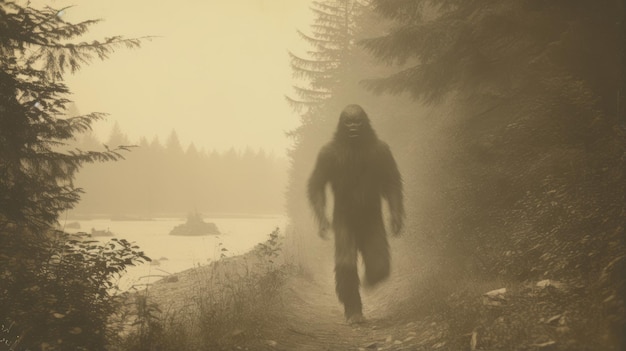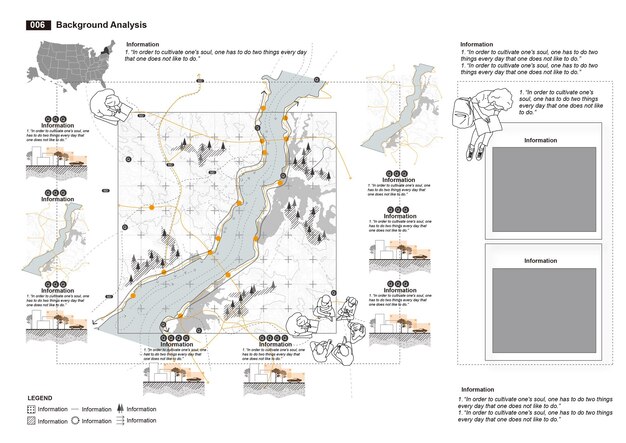Bigfoot Search: DNA Evidence & Sightings in the Pacific Northwest

The search for Bigfoot continues, fueled by alleged sightings and recent DNA evidence analyses in the Pacific Northwest, sparking debate and scientific curiosity.
The elusive creature known as Bigfoot, or Sasquatch, has captivated imaginations for decades. The enduring mystery surrounding the search for Bigfoot: Latest DNA Evidence and Reported Sightings in the Pacific Northwest, continues to pique interest and generate debate.
The Enduring Enigma of Bigfoot
The legend of Bigfoot has persisted for generations, with countless stories and alleged sightings fueling the mystery. This enigmatic creature, often depicted as a large, hairy hominid, has become a cultural icon. But what is the current status of the evidence supporting its existence?
Let’s delve in the latest developments, including DNA analyses and reported sightings, and explore the facts and theories surrounding this fascinating cryptid.

Historical Roots and Cultural Significance
The legend of Bigfoot extends back centuries, deeply embedded in the folklore of Native American tribes. Passed down through oral traditions, these stories often portray a large, hairy being inhabiting the remote wilderness.
- Native American legends depict Bigfoot as a guardian of the forest, a powerful and elusive entity.
- Early European settlers encountered these stories, further fueling the mystique surrounding the creature.
- The name “Sasquatch” originates from the Halkomelem word “sesqac,” used by indigenous peoples in British Columbia.
The cultural significance of Bigfoot goes beyond mere folklore. It represents the allure of the unknown, the enduring power of myth, and the human desire to connect with the natural world.
Decoding the DNA: Unraveling the Mystery
In recent years, DNA analysis has emerged as a potentially groundbreaking tool in the search for Bigfoot. Several research groups have attempted to extract and analyze DNA from alleged Bigfoot hair samples, footprints, and other materials. But how credible are these findings?
Let’s examine the challenges and controversies surrounding Bigfoot DNA research and evaluate the evidence presented.
The Challenges of Bigfoot DNA Analysis
Analyzing DNA from purported Bigfoot samples is fraught with challenges. Contamination from human and animal sources, degradation of DNA over time, and the lack of a known Bigfoot DNA reference sequence all complicate the process.
Researchers must carefully control for these factors to ensure the validity of their results.
Reported DNA Findings: Fact or Fiction?
Several studies have claimed to have identified Bigfoot DNA, but these findings have often been met with skepticism from the scientific community. Most DNA analyses ultimately come back as known animal DNA profiles. Here’s a look at what has been uncovered recently:
- Some studies have reported finding DNA sequences that do not match any known species, leading to speculation about a novel hominid.
- However, these results are often questioned due to the possibility of contamination or errors in the analysis.
- Other studies have identified DNA from known animals such as bears, deer, and coyotes in purported Bigfoot samples.
While DNA analysis holds promise for shedding light on the Bigfoot mystery, further research with rigorous scientific controls is needed to provide conclusive evidence.
Hotspots of Activity: Bigfoot Sightings in the Pacific Northwest
The Pacific Northwest region of the United States and Canada has long been considered a hotspot for Bigfoot sightings. The dense forests, rugged terrain, and remote wilderness areas provide ideal habitat for a large, elusive creature. But where are the most active locations, and what patterns can be observed?
Let’s explore some of the most notable Bigfoot sighting areas in the Pacific Northwest and examine the characteristics that make them attractive to the creature.
Specific Locations and Historical Data
Bigfoot sightings have been reported throughout the Pacific Northwest, but certain areas appear to be more active than others.
These include the Olympic Peninsula, the Cascade Mountains, and the Siskiyou Mountains. Historical patterns may suggest increased activity at certain periods:
- The Olympic Peninsula in Washington State is known for its dense forests and rugged coastline, providing ample cover for Bigfoot.
- The Cascade Mountains, stretching from British Columbia to Northern California, offer a vast and varied habitat.
- The Siskiyou Mountains, located in southwestern Oregon and northern California, are characterized by their remote and mountainous terrain.
These regions share several characteristics that may make them attractive to Bigfoot, including abundant food sources, water, and shelter.

Analyzing Reported Sightings Patterns
Analyzing the patterns of reported Bigfoot sightings can provide valuable clues about the creature’s behavior and habitat preferences. Factors such as the time of year, weather conditions, and terrain type can all influence sighting frequency. Some researchers have argued activity spikes coincide with animal migration:
Researchers examine the following when reviewing alleged sightings:
- Sightings are more common during the summer and fall months, when the weather is milder and food is more abundant.
- Sightings are often clustered around water sources such as rivers, lakes, and streams.
- Sightings are more likely to occur in areas with dense vegetation and limited human activity.
By studying these patterns, researchers hope to gain a better understanding of Bigfoot’s habits and movements.
Expert Opinions: Scientists, Researchers, and Cryptozoologists
The search for Bigfoot has attracted the attention of scientists, researchers, and cryptozoologists, each with their own perspectives and expertise. While some dismiss the creature as a myth, others believe that compelling evidence warrants further investigation. What do these experts have to say about the latest developments in the Bigfoot mystery?
Here’s a look at opinions from the experts and how their expertise shapes arguments on the Bigfoot phenomenon.
The Scientific Skeptic: A Critical Examination
Many scientists remain skeptical about the existence of Bigfoot, citing the lack of conclusive evidence and the prevalence of hoaxes and misidentification. These experts emphasize the importance of rigorous scientific methodology and critical thinking when evaluating claims of Bigfoot sightings or DNA evidence.
Skeptics contend the following:
They may say:
- There is no credible physical evidence of Bigfoot, such as a body or skeleton.
- Reported sightings are often the result of misidentification of known animals or natural phenomena.
- Purported Bigfoot DNA samples are often contaminated or misidentified.
While acknowledging the enduring appeal of the Bigfoot legend, scientific skeptics argue that extraordinary claims require extraordinary evidence.
The Cryptozoologist: Pursuing the Unexplained
Cryptozoologists, on the other hand, actively investigate reports of unknown or undocumented animals, including Bigfoot. These researchers often rely on anecdotal evidence, eyewitness accounts, and footprint evidence to build their case. Cryptozoologists focus on identifying the following:
They study:
- They argue that the sheer number of reported sightings and the consistency of descriptions suggest the possibility of a real creature.
- They point to alleged Bigfoot footprints as evidence of a large, unknown primate.
- Some cryptozoologists believe that Bigfoot is a surviving population of Gigantopithecus, an extinct giant ape.
While often criticized for their lack of scientific rigor, cryptozoologists play an important role in keeping the Bigfoot mystery alive and encouraging further investigation.
The Role of Technology: Enhancing the Search
Advancements in technology have provided new tools and techniques for investigating the Bigfoot mystery. From trail cameras and drones to DNA sequencing and geographic information systems (GIS), technology is playing an increasingly important role in the search for the elusive creature. How are these technologies being used, and what are their potential benefits and limitations?
Let’s explore the role of technology in enhancing the search for Bigfoot and the latest tech being used.
Trail Cameras and Remote Monitoring
Trail cameras, also known as game cameras, are widely used by Bigfoot enthusiasts to capture images and videos of potential Bigfoot activity. These cameras are typically placed in remote areas and triggered by motion or heat sensors. Some cameras have been deployed for years to monitor activity.
They provide detailed images and video if the trigger is pulled.
Drones and Aerial Surveillance Efforts
Drones, or unmanned aerial vehicles (UAVs), offer a new perspective on Bigfoot hunting, allowing researchers to survey large areas quickly and efficiently. Drones can be equipped with high-resolution cameras, thermal imaging sensors, and other sensors to detect potential Bigfoot activity. Thermal cameras are used to spot potential life forms:
Drones can be used to:
- Search for footprints, trails, and other signs of Bigfoot
- Monitor remote areas that are difficult to access on foot
- Capture aerial footage of potential Bigfoot habitats
However, the use of drones also raises concerns about privacy and environmental impact.
Hoaxes vs. Reality: Separating Fact from Fiction
The Bigfoot phenomenon is often plagued by hoaxes and misidentification. From fabricated footprints to staged videos, the desire for attention or financial gain has motivated some individuals to create fraudulent evidence. How to approach accounts with skepticism:
Let us consider how to differentiate between genuine sightings and intentional hoaxes.
Notable Cases of Hoaxes and Misidentifications
Over the years, several high-profile Bigfoot sightings have been revealed as hoaxes. The Patterson-Gimlin film, a short film purportedly showing a female Bigfoot, is one of the most famous examples. However, the film has been widely debated, with some skeptics claiming that it is a hoax staged with a person in a costume.
What needs to be considered:
- Examine the credibility and motivations of the person reporting the sighting.
- Evaluate the consistency of the evidence with known facts about Bigfoot.
- Consider the possibility of misidentification of known animals or natural phenomena.
By applying a critical and skeptical approach, investigators can better separate fact from fiction in the Bigfoot narrative.
| Key Point | Brief Description |
|---|---|
| 👣 Sightings | Pacific Northwest region has the most sightings. |
| 🧬 DNA Analysis | Numerous studies claim it, but findings are controversial. |
| 🔍 Technology | Researchers using trail cams and drones for surveillance. |
| ❓ Skepticism | Existence not verified, hoaxes have been known. |
Frequently Asked Questions
▼
DNA sequence results from alleged samples have been controversial and not consistently verifiable as unique.
▼
Olympic Peninsula, the Cascade Mountains, and Siskiyou Mountains have the most Bigfoot sighting reports.
▼
Trail cameras, drones, and remote sensing technologies assist researchers in surveillance.
▼
Skepticism is key in evaluating and separating legitimate sightings from the fabricated ones.
▼
Drones assist researchers in the remote areas with otherwise hard-to-reach surveillance opportunities.
Conclusion
The search for Bigfoot continues to captivate, blending folklore with modern science. While DNA evidence remains inconclusive and sightings often lack definitive proof, ongoing investigations and technological advancements keep the mystery alive, urging researchers and enthusiasts alike to pursue the truth behind this elusive creature.